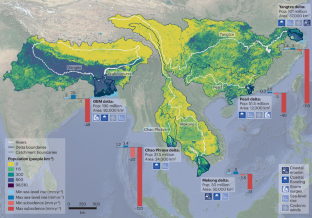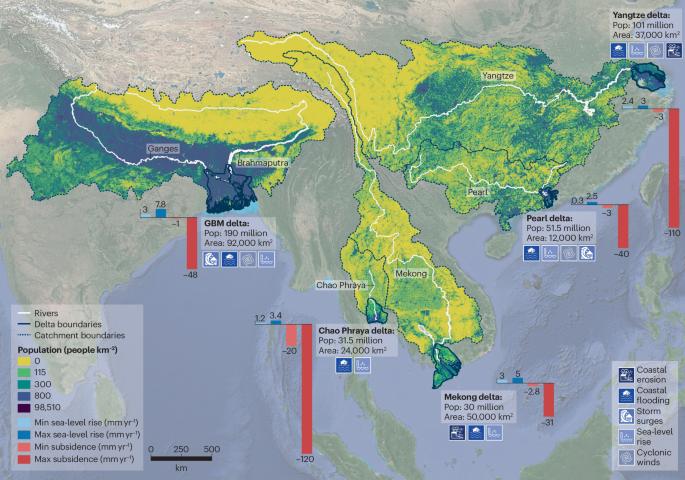Building resilience in Asian mega-deltas
引用次数: 0
Abstract
The five Asian mega-deltas (the Yangtze, the Pearl, the Chao Phraya, the Mekong and the Ganges–Brahmaputra–Meghna deltas) are home to approximately 80% of the global deltaic population and the region experiences 90% of global flood exposure. In this Review, we investigate the similarities and differences between the Asian mega-deltas to identify transferable lessons to improve climate resilience. The deltas are increasingly threatened by coastal flooding, saline intrusion and erosion caused by climate change and human activities such as groundwater extraction and dam construction. Owing to differences in the stages of their development, various resilience measures have been implemented. For example, the Ganges–Brahmaputra–Meghna and Mekong deltas use strategic delta plans to identify risk hotspots and guide decision-making. These deltas also increase resilience at a community level by supporting communities to diversify their livelihoods to respond to changing risks and land conditions. Meanwhile, the Yangtze and Pearl deltas have developed forecasting and sensing technologies to allow them to prepare for and respond to hazards effectively. The Asian mega-deltas should learn from one another to integrate effective resilience plans across regional, delta and community levels. Future cross-delta collaborations and knowledge transfer, for example through the formation of a Regional Delta Resilience Alliance, could help to achieve long-term sustainable delta management. Climate change and human activities are increasing the exposure of deltaic communities to natural hazards. This Review discusses lessons that the Asian mega-deltas can share to develop long-term resilience strategies.


建设亚洲特大三角洲的抗灾能力
亚洲五大三角洲(长江三角洲、珠江三角洲、湄南河三角洲、湄公河三角洲和恒河-布拉马普特拉河-孟加拉河三角洲)居住着全球约 80% 的三角洲人口,该地区遭受了全球 90% 的洪灾。在本综述中,我们研究了亚洲特大三角洲之间的异同,以找出可借鉴的经验教训,提高气候抵御能力。由于气候变化以及地下水开采和大坝建设等人类活动,三角洲正日益受到沿海洪水、盐水入侵和侵蚀的威胁。由于其发展阶段不同,已经实施了各种抗灾措施。例如,恒河-rahmaputra-Meghna 三角洲和湄公河三角洲利用战略三角洲计划来确定风险热点并指导决策。这些三角洲还通过支持社区实现生计多样化来应对不断变化的风险和土地条件,从而提高社区一级的抗灾能力。与此同时,长江三角洲和珠江三角洲开发了预报和传感技术,使其能够有效应对灾害。亚洲特大三角洲应相互学习,在区域、三角洲和社区层面整合有效的抗灾计划。未来的跨三角洲合作和知识转让,例如通过成立区域三角洲抗灾联盟,将有助于实现长期可持续的三角洲管理。
本文章由计算机程序翻译,如有差异,请以英文原文为准。
求助全文
约1分钟内获得全文
求助全文

 求助内容:
求助内容: 应助结果提醒方式:
应助结果提醒方式:


